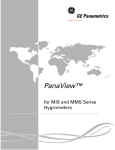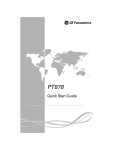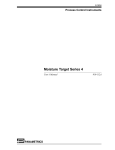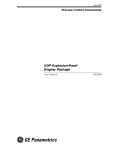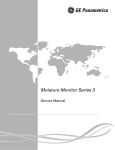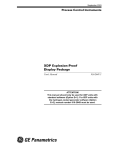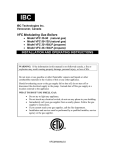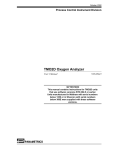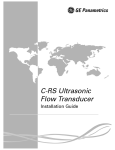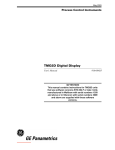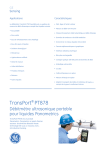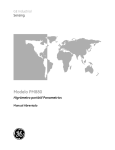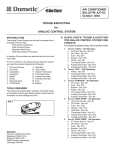Download PanaView™ for the PT878 - GE Measurement & Control
Transcript
PanaView™ for the PT878 September 2003 Process Control Instruments PanaView™ for the PT878 User’s Guide 916-090A1 July 2003 Table of Contents Introduction. . . . . . . . . . . . . . . . . . . . . . . . . . . . . . . . . . . . . . 1 Connecting the IR232 Interface . . . . . . . . . . . . . . . . . . . . . . 2 Establishing Communications with PanaView. . . . . . . . . . . 3 Setting Up the Communications Port. . . . . . . . . . . . . . . 3 Adding the PT878 . . . . . . . . . . . . . . . . . . . . . . . . . . . . . 6 Programming a PT878 with PanaView. . . . . . . . . . . . . . . . 11 Setting Up Initial Parameters . . . . . . . . . . . . . . . . . . . . 11 Setting Up the Energy Option . . . . . . . . . . . . . . . . . . . 24 Setting Up Inputs and Outputs . . . . . . . . . . . . . . . . . . . 27 Programming User Functions . . . . . . . . . . . . . . . . . . . 33 Entering User Tables . . . . . . . . . . . . . . . . . . . . . . . . . . 35 Entering Correction Factors . . . . . . . . . . . . . . . . . . . . . 37 Entering Service Parameters . . . . . . . . . . . . . . . . . . . . 40 Checking the Battery and Backlight . . . . . . . . . . . . . . . . . . 46 Changing Displayed Measurement Parameters and Units . 47 Setting PanaView Measurement Units . . . . . . . . . . . . . . . . 50 i July 2003 Introduction The PanaView™ graphical user interface offers interactive communications between Windows-based PCs and the GE Panametrics PT878 portable flowmeter. (Compatible 32-bit Windows operating systems include Windows 98SE, NT 4.0 (with Service Pack 6), 2000, XP and ME). With PanaView, you can: • set meter parameters to control the instrument • create and save graph and log files • display text output and graphs of live measurement data • create custom templates for displaying text, graph and log data • interface with multiple GE Panametrics instruments. This document focuses on particular applications of PanaView for the PT878 flowmeter. For general PanaView applications such as creating graph and log files, displaying live measurement data, and creating custom templates, please refer to the general PanaView User’s Manual (910-211). PanaView for the PT878 1 July 2003 Connecting the IR232 Interface On the PT878, an internal infrared transceiver enables communication between the meter and IR ports or dongles (IR to RS232 adapters) of Windows®-based PCs. However, the typical desktop PC setup does not offer a built-in IR port. Therefore, to establish IR communications, you must connect the RS232 adapter of an IR dongle (such as the Actisys 220L+ shown in Figure 1a below) to an available COM port on the PC (Figure 1b). (a) (b) Figure 1: IR Dongle (a) Connected to RS232 Port (b) Note: The PT878 was designed for use with products that comply to the IrDA protocol. For more information on establishing IR communications between the PT878 and your PC, refer to Appendix F of the PT878 User’s Manual. 2 PanaView for the PT878 July 2003 Establishing Communications with PanaView After you have connected the IR dongle to a communications port of your PC, the procedure for establishing communications with a meter may be started. Be sure that the IR beam on the PT878 has clear access to the IR sensor face on the dongle connected to the PC port. Setting Up the Communications Port Use the steps below to establish communications with a PT878 flowmeter. 1. Open the “New Meter Browser” window and expand the network tree. Then, highlight the My Computer (Name) branch by clicking on it. 2. Pull down the “Edit” menu by clicking on it in the menu bar. 3. Click on the “New” menu option to select it, and a submenu opens with two choices on it (see Figure 2 below). Figure 2: The Edit Menu PanaView for the PT878 3 July 2003 Setting Up the Communications Port (cont.) 4. Click on the “Communications Port” option to select it. The Setup Communications screen appears similar to Figure 3 below. Figure 3: Setup Communications Screen 5. Open the Protocol menu (the first of the drop-down menus) and click on PanaLink. 6. Select the communications port (COM1 or COM2) from the drop-down menu. 7. In the Name text box, enter a name for the communications port. 4 PanaView for the PT878 July 2003 Setting Up the Communications Port (cont.) 8. For the Com Port type, select either IrDA or IR232. IMPORTANT: IR232 generally provides better performance than IrDA. If you select IR232, you must disable the drivers in the infrared device connected to your PC for the device to work with PanaView. From the Control Panel, click on the System icon, and then on the Hardware tab. Click on Device Manager, and then on the specific infrared device listed under Infrared Devices. Finally, click on Disable to disable the device drivers. 9. You now have two options: • If you have selected IrDA, you have finished entering parameters in this window. • If you have selected IR232, select the following settings for the remaining parameters: • Baud Rate — 19,200 • Parity — None • Data Bits — 8 • Stop Bits — 1 IMPORTANT: Be sure all the communications port settings match those in the meter’s Communications option. 10.Click on [OK] to complete data entry. PanaView for the PT878 5 July 2003 Adding the PT878 To add a PT878 meter on the IR232-configured communications port, complete the following steps: 1. Highlight the communication port to which the meter will be added by clicking on it, and then open the “Edit” menu on the menu bar (if the communication port is not highlighted first, the “New Meter” option is not active in the “Edit” menu). 2. Click on the “New” option in the “Edit” menu (see Figure 4 below). Figure 4: "New" Option in the "Edit" Menu 3. After clicking on the “New” option, the “Meter” menu option appears. Click on this option to select it. 4. After selecting the “New” and “Meter” options, the dialog box shown in Figure 5 on the next page appears. Select the “I don’t know the node ID of the meter I am adding to the network” radio button and then click on the [OK] option button. Note: When installing the first meter on the network, even if you know the node ID assigned to the meter, it is more foolproof to allow PanaView to retrieve the information directly from the meter. If the “I know the node ID of the meter I am adding to the network.” option is selected instead, the process skips directly to Step 8 on page 9. 6 PanaView for the PT878 July 2003 Adding the PT878 (cont.) Figure 5: The Node ID Dialog Box 5. After responding to the previous dialog box, the dialog box shown in Figure 6 below appears. In this instance, the PT878 communicates via an IR232 dongle connected to the comport. Therefore, select the “It is the only meter connected to the communication port” radio button and then click on the [OK] option button. Figure 6: The Only Meter Dialog Box PanaView for the PT878 7 July 2003 Adding the PT878 (cont.) 6. After responding to the previous dialog box, a dialog box showing the Node ID (16 in this example) of the meter appears (see Figure 7 below). Select the “I wish to use this Node ID” radio button and then click on the [OK] option button. Note: PanaView gets this Node ID directly from the meter; do not use a different Node ID for a single-meter setup. Figure 7: Node ID Confirmation Figure 8: Confirmation Dialog Box 8 PanaView for the PT878 July 2003 Adding the PT878 (cont.) 7. At the dialog box shown in Figure 8 on the previous page, click on the [OK] option button to add the meter and configure it. The dialog box shown in Figure 9 below appears. Figure 9: The Add Meter Dialog Box 8. In the dialog box above, enter a name for the new meter. The Node ID and Meter Communication Parameters have been entered automatically by PanaView. In addition, PanaView populates certain other fields, such as “Model Name,” “Firmware Version,” and “PCI Order Number” with data retrieved from the GE Panametrics instrument. Click on the [OK] option button to initialize the new meter. PanaView for the PT878 9 July 2003 Adding the PT878 (cont.) After completing this step, do not make any inputs with either the mouse or the keyboard until the new meter initialization process is completed. While the meter is initializing, the information shown in Figure 10 below is added to the new meter dialog box. Figure 10: The Initialization Screen Note: The “Clock” text box has been filled in with the current date and time, the name “PT878” has been added, and the active communications status is being displayed along the bottom of the dialog box. After the initialization has been completed, PanaView adds the new meter to the PanaView network tree and automatically closes the “Add New Meter” dialog box. 10 PanaView for the PT878 July 2003 Programming a PT878 with PanaView PanaView enables you to remotely change the programming of your PT878 flowmeter. You can perform a variety of operations: • Set up the initial transducer and pipe parameters, • Program the Energy Option, • Set up inputs and outputs, • Add, change or delete user equations and user tables, • Program certain service parameters, • Check the battery and backlight, • Display meter measurements on your PC, • Vary modes and display units. For a complete explanation of PanaView’s capabilities, see the PanaView User’s Manual (910-211). Setting Up Initial Parameters Through PanaView, you can remotely program essential data for a given PT878 site — the transducer, pipe, lining (for clamp-on transducers), fluid and path parameters. (These parameters are discussed in Chapter 3, Programming Site Data, of the PT878 User’s Manual.) To program initial setup data: 1. From the “File” menu, click on the “New Meter Browser” option. 2. From the network tree, click on the desired communications port (COM 1, etc.) and meter. 3. From the expanded tree, click on the “Channel 1” option. The listing appears similar to Figure 11 on the next page. PanaView for the PT878 11 July 2003 Setting Up Initial Parameters (cont.) Figure 11: Meter Menu for PT878 4. To enter basic setup parameters, click on the “Program” option. The PT Setup window opens, as shown in Figure 12 on the next page. 12 PanaView for the PT878 July 2003 Setting Up Initial Parameters (cont.) Figure 12: The PT Setup Window Note: The choices made in the Transducer and Pipe options determine the later programming options. If a tab or parameter has been “grayed out,” it is either preprogrammed by an earlier choice or not necessary for that transducer or pipe type. For example, the Lining form is not available for wetted transducers. PanaView for the PT878 13 July 2003 Transducer Setup The first option in the PT Setup window allows you to set up parameters for the transducers you have installed. Refer to the Liquid Transducer Installation Guide (916-055) for additional information about transducers and configurations. 1. The first prompt asks you to select the type of transducer, either wetted or clamp-on. Click on the desired radio button. 2. The list at the left of the window now lists the available preprogrammed or special transducers for your transducer type. Click on the desired transducer number, or on SPECIAL if your transducer is not listed. If you have selected a transducer on the list, the PT878 supplies PanaView with the needed parameters. Click on another tab to continue programming. However, if you have selected SPECIAL, continue as shown below. Special Transducers The window appears similar to Figure 13 below. Figure 13: The Transducer Form for a Special Transducer 14 PanaView for the PT878 July 2003 Special Transducers (cont.) 3. PanaView asks for the transducer frequency. Open the dropdown list of five frequencies, and click on the desired frequency. 4. The next prompt requires the time delay (the time the signal takes to travel through the transducer and cable). Click in the Time Delay text box, and enter the GE Panametrics-supplied time delay. 5. PanaView now asks for the wedge angle (the angle of the ultrasonic transmission). Click in the Wedge Angle box, and enter the GE Panametrics-supplied wedge angle. 6. The next prompt asks for the wedge temperature. Click in the Wedge Temperature box, and enter the temperature. 7. The final prompt asks for the wedge sound speed. Click in the Wedge Sound Speed text box, and enter the GE Panametricssupplied sound speed. You have completed entering data in this option. Click on another tab to continue programming. PanaView for the PT878 15 July 2003 Pipe Setup The Pipe option appears similar to Figure 14 below. Figure 14: The Pipe Option 1. The first prompt asks for the pipe material. From the list in the left window of the option, scroll to the appropriate material and click on it, or on “Other” if your material is not listed. a. If you select “Other,” you must enter the sound speed. Click in the sound speed text box, and enter the desired sound speed. 16 PanaView for the PT878 July 2003 Pipe Setup (cont.) 2. PanaView now asks for the pipe outside diameter. Click in the Outside Diameter text box to enter the diameter, and in the Wall Thickness text box to enter the wall thickness. or If you select certain materials (carbon or stainless steel, cast iron, PVC and CPVC), you can use the DIN pipe standard to enter the pipe dimensions. a. Click in the check box to obtain the DIN pipe standard. b. At the Nominal option, pull down the drop-down menu and click on the desired pipe size. c. At the Schedule option, pull down the drop-down menu and click on the desired schedule. 3. You have finished entering data in this option. Click on another tab to continue programming, or click on [Apply] to immediately apply the changes, and on [OK] to confirm the changes and close the window. (To return the window to its previous settings, click on the [Cancel] button.) PanaView for the PT878 17 July 2003 Fluid Setup The Fluid window appears similar to Figure 15 below. Figure 15: The Fluid Option 1. The first prompt asks if you want to use tracking windows, which detect the receive signal when you are unsure of the fluid sound speed. Click on the box if you wish to use tracking windows. 2. You must next select the desired fluid. From the list in the left window of the option, scroll to the desired fluid and click on it. For all selections except “Other,” PanaView supplies the sound speed, along with minimum and maximum values. You have completed entering data in this option. But if you selected “Other” and “Tracking Windows,” continue to step 3. 3. For the sound speed value, minimum and maximum sound speeds, and glycol percentage (if available), click in the appropriate text box and enter the desired values. 4. You have finished entering data in this option. Click on another tab to continue programming, or click on [Apply] to immediately apply the changes, and on [OK] to confirm the changes and close the window. (To return the window to its previous settings, click on the [Cancel] button.) 18 PanaView for the PT878 July 2003 Lining Setup Note: This option is only available if you have selected a clampon transducer in the Transducer option. The Lining option appears similar to Figure 16 below. Figure 16: The Lining Option 1. PanaView asks you to select the lining material. From the list in the window at the left, click on the desired lining. a. For all options except “Other,” PanaView supplies the lining sound speed. But if you have selected “Other,” click in the Sound Speed text box and enter the desired sound speed. 2. You must now enter the material thickness. Click in the Thickness text box and enter the desired thickness. 3. You have finished entering data in this option. Click on another tab to continue programming, or click on [Apply] to immediately apply the changes, and on [OK] to confirm the changes and close the window. (To return the window to its previous settings, click on the [Cancel] button.) PanaView for the PT878 19 July 2003 Path Setup The Path option appears similar to Figure 17 below. Figure 17: The Path Option 1. If you are using wetted transducers, you must enter the Path Length and Axial Length. For each value, click in the text box and enter the GE Panametrics-supplied value. 2. If you are using clamp-on transducers, the PT878 enters the transducer spacing; however, you can use the text box to override the spacing. You can also enter the number of traverses (times the ultrasonic signal crosses the pipe). For each value, click in the text box and enter the appropriate value. 3. You have finished entering data in this option. Click on another tab to continue programming, or click on [Apply] to immediately apply the changes, and on [OK] to confirm the changes and close the window. (To return the window to its previous settings, click on the [Cancel] button.) 20 PanaView for the PT878 July 2003 Rebuilding the Database If you have a problem opening the setup window, you might wish to rebuild the PT878 database. Click on the [Rebuild DB] button at the far left of the PT Setup window, as shown in Figure 17 on the previous page. The text boxes gray out, and the window appears similar to Figure 18 below. Figure 18: The PT Setup Window, as PanaView Rebuilds the Database Rebuilding the database will take a few minutes. Please wait while PanaView rebuilds the database. When PanaView has finished, click on another tab to continue programming, or click on [OK] to confirm the changes and close the window. PanaView for the PT878 21 July 2003 Viewing Signals To view the raw signal received by the current PT878 setup, click on the [Signals] button at the left of the PT Setup window. The Signal Graph window opens, as shown in Figure 19 below. Figure 19: The Signal Graph Window 1. From the drop-down menu at the lower left of the window, you can choose from five signal types: Raw Up or Down, Correlation Up or Down, and Cross-Correlation (XCorr). Pull down the menu and click on the desired signal. 2. To select the signal group, click on the radio button for group 1 or 2. 3. If you wish to show the graph points, click on the Show Points box. 4. You can now choose from three options: 22 • Click on [Clear] to clear any previous graph from the window. • Click on [Plot] to plot the signal as a graph. The graph appears similar to Figure 20 on the next page. • Click on [Close] to close the window and return to the PT Setup menu. PanaView for the PT878 July 2003 Viewing Signals (cont.) Figure 20: A Cross-Correlation Signal Graph PanaView for the PT878 23 July 2003 Setting Up the Energy Option To set up energy measurement parameters, click on the “Energy” option shown in Figure 11 on page 12. The window appears similar to Figure 21 below. Figure 21: The Energy Option Window 1. The first prompt asks if you wish to enable or disable the Energy Option. Click on the appropriate radio button to enable or disable the option. Note: If you click on “Disabled,” you will not be able to enter any other parameters in this option. 2. The next prompt asks if you are measuring a heating or cooling system. Click on the desired button. 3. The final prompt asks if you are measuring flow at the point of supply or return. Click on the appropriate button. 24 PanaView for the PT878 July 2003 Setting Up Inputs in the Energy Option To set up inputs for the Energy Option, click on the “Inputs” tab at the top of the window. The screen now appears similar to Figure 22 below. Figure 22: Inputs in the Energy Option 1. The first prompt asks you to select a fixed or active input for the supply temperature. Click on the desired radio button. 2. The next prompt varies with your choice in step 1. • If you selected “Fixed,” the program asks for a specific temperature. Enter the desired temperature in the text box. • If you selected “Active,” the program asks you to select the input. From the drop-down menu, click on “A” or “B.” PanaView for the PT878 25 July 2003 Setting Up the Energy Option (cont.) You have finished entering data in the Energy Option. Click on [Apply] to immediately apply the changes, and on [OK] to confirm the changes and close the window. (To return the window to its previous settings, click on the [Cancel] button.) 26 PanaView for the PT878 July 2003 Setting Up Inputs and Outputs To set up the PT878 input and output parameters, click on the “Meter I/O” option shown in Figure 11 on page 12. The tree expands to show three options, “Analog Output,” “Analog Input,” and “Digital Output.” These options correspond to the options in the PT878 Program menu, and are described in Chapter 3, Programming Site Data, of the PT878 User’s Manual. To access a particular option, double-click on the listing in the menu tree. Note: Unlike other options, the input and output options accept and display values only in the unit type (English or metric) selected in the PT878. Setting Up the Analog Output The window appears similar to Figure 23 below. Figure 23: Analog Output Window in the Meter I/O Menu PanaView for the PT878 27 July 2003 Setting Up the Analog Output (cont.) 1. You must first select the output function. From the drop-down menu, click on one of three choices: Off, 0-20 mA or 4-20 mA. 2. The program next asks for a data source. Click on the “Select Data Source” window, and a second window opens listing the available parameters and units. Click on the desired units. 3. You must next enter the zero value. Type the desired value in the text box. 4. You must next enter the span value. Type the desired value in the text box. 5. The last prompt, On Error, asks you to select how the PT878 will handle the analog outputs in the event of a fault condition. You can choose from three alternatives: • Hold Last Value (hold the last good reading) • Force Low (force the reading to 0 or 4 mA) • Force High (force the reading to 20 mA). From the drop-down menu, click on the desired alternative. You have finished entering Analog Output data. Click on [Apply] to immediately apply the changes, and on [OK] to confirm the changes and close the window. (To return the window to its previous settings, click on the [Cancel] button.) 28 PanaView for the PT878 July 2003 Setting Up the Analog Inputs The window appears similar to Figure 24 below. Figure 24: The Analog Input Window 1. The first prompt asks for an input function. From the dropdown menu, click on either “Off” or “General Purpose.” Note: If you select “Off,” you will not be able to access any other parameters in this window. Also, if you have enabled the Energy Option (page 24), the function will be either “Supply Temp” or “Return Temp.” 2. The following prompts ask for an input label and input units. Enter the desired label and units in the appropriate text boxes. Note: If you have enabled the Energy Option, the Label and Unit boxes are not available. 3. The remaining prompts ask for the zero and span values. Enter the desired values in the appropriate text boxes. You have finished entering Analog Input data. Click on [Apply] to immediately apply the changes, and on [OK] to confirm the changes and close the window. (To return the window to its previous settings, click on the [Cancel] button.) PanaView for the PT878 29 July 2003 Setting Up the Digital Output The window appears similar to Figure 25 below. Figure 25: The Digital Output Window, with the Pulse Totalizer Function Selected 1. The first prompt asks you to select a function type. From the drop-down menu at the upper right of the window, click on one of five choices: • • • • • Off Pulse Totalizer Frequency Test Points Gate Input The functions and their associated parameters correspond to those available in the Digital Output option of the PT878 Program Menu. Note: If you select “Off,” you will not be able to access any other parameters in this function. 30 PanaView for the PT878 July 2003 Setting Up the Digital Output (cont.) 2. The next prompt asks you to select a data source. Click on the “Get Data Source” button. A second window opens, with a meter tree of available parameters and units. Click on the desired unit. 3. The parameters now vary with the selected function. • If you selected Pulse Totalizer: The prompt asks for the units/pulse, the pulse width (in microseconds), and the polarity. a. For Units/Pulse, click in the text box, and use the numeric keys to enter the desired value. b. For Pulse Width, open the drop-down menu and click in the desired width in microseconds: 10, 20, 40 or 80. c. For Polarity, open the drop-down menu and scroll to the desired polarity, either Low to High or High to Low. • If you selected Frequency: The program asks for the minimum and maximum frequencies and the duty cycle percentage. For each parameter, click in the text box, and use the numeric keys to enter the desired value. • If you entered Test Points: The prompt asks for the signal type from two choices, transmit and receive. Open the drop-down menu, and click on the desired signal. • If you entered Gate Input: a. The first prompt asks for the gate active. From the dropdown menu, click on the desired gate active, whether Contact Open or Contact Closed. b. The second prompt asks for the mode. From the dropdown menu, Click on the desired mode, either Automatic or Manual. PanaView for the PT878 31 July 2003 Setting Up the Digital Output (cont.) You have completed entering parameters in the Digital Output option. Click on [Apply] to immediately apply the changes, and on [OK] to confirm the changes and close the window. (To return the window to its previous settings, click on the [Cancel] button.) 32 PanaView for the PT878 July 2003 Programming User Functions As explained in the PT878 User’s Manual, user functions enable operators to program mathematical equations on each measurement, or to use any measured parameter to calculate a different parameter. PanaView allows users to program or change user functions and related tables through the PC. To program a user function: 1. From the “New Meter Browser” option, click on the desired communications port, meter, and channel. 2. Click on “User Functions,” and then double-click on the desired function (1 to 4). The right side of the screen appears similar to Figure 26 below. Figure 26: The User Function Window PanaView for the PT878 33 July 2003 Programming User Functions (cont.) 3. Enter three parameters: • a function label (of no more than 16 characters) • a function symbol (no more than 4 characters), and • the number of decimal places desired. 4. To incorporate an existing parameter, pull down the network menu and click on the desired channel, measurement and display unit. 5. To select the desired operation or table, click on the appropriate button. (See Entering User Tables on the next page for information on entering data for user tables.) Use the cursor in the equation box to position values correctly, or to erase incorrect values or operations. 6. To enter numeric values, use the numeric keys on your PC keyboard. 7. When you have completed entering the function, click on [Apply] to apply the function immediately, and on [OK] to confirm the function and close the window. To return the window to its previous settings, click on the [Cancel] button. Note: It may be advisable to use the [Apply] button as a means of checking the function’s validity. If the function is improperly typed, or if a sensor is under range or not programmed, the Equation line displays “Invalid” with a brief message. 34 PanaView for the PT878 July 2003 Entering User Tables To support user functions, the PT878 flowmeter can hold up to five tables (designated as A through E) of non-linear or empirical data. Users can enter up to 16 X-Y pairs in each table. A user function can supply an X value with Tbl(). The meter then interpolates the Y value for a given X, and substitutes it for Tbl (X) in the function. (See the section Setting Up User Tables in the PT878 User’s Manual.) To enter values for a user table: 1. From the “New Meter Browser” option, click on the desired communications port and meter. 2. Click on “User Tables,” and then double-click on the desired table.The right side of the screen appears similar to Figure 27 below. Figure 27: User Table Window 3. Enter a name (up to 13 characters) for the table in the “Table Name” text box, and enter up to 16 X and Y values in the appropriate columns.The table now appears similar to Figure 28 on the next page. PanaView for the PT878 35 July 2003 Entering User Tables (cont.) Figure 28: Completed User Table When you have finished entering values, click on [Apply] to apply the table immediately, and on [OK] to confirm the table and close the window. To return the window to its previous settings, click on the [Cancel] button. 36 PanaView for the PT878 July 2003 Entering Correction Factors The Correction Factors option allows you to enter and modify three correction factors: Reynolds Correction, Kinematic Viscosity and Calibration Factor. To enter the Correction Factors option, double-click on the Correction Factors entry in the Meter menu shown in Figure 11 on page 12. The screen appears similar to Figure 29 below. Figure 29: The Reynolds Correction Tab in the Correction Factors Window 1. The first prompt asks if you want to enable the Reynolds Correction factor, a number based on the Kinematic Viscosity and flow rate of the fluid. Click on the desired radio button. Note: If you have enabled Tracking Windows, you must enable Reynolds Correction. Also, if you disable Reynolds Correction, you will be unable to enter any other parameters in this window. 2. The last prompt asks you to enter a Kinematic Viscosity number. Enter the number in the text box. PanaView for the PT878 37 July 2003 Entering the Calibration Factor To open the Calibration Factor window, click on the “Calibration Factor” tab on the right of the Correction Factors window. The screen now appears similar to Figure 30 below. Figure 30: The Calibration Factor Tab in the Correction Factors Window 1. The first prompt asks you to turn calibration correction on or off. Click on the desired radio button. Note: If you turn calibration correction off, you will not be able to access any other parameters in this window. 2. The next prompt asks you to select a single K Factor or a table of K Factors. Click on the desired radio button. 3. The program varies, depending on your selection in step 2. • 38 If you select “Single,” enter a single value in the Meter KFactor text box. PanaView for the PT878 July 2003 Entering the Calibration Factor (cont.) • If you select “Table,” the program asks you to complete the table. a. The first step is to select a data source. Click on the “Select Data Source” button. A second window opens, showing a PT878 tree with available parameters and units. Click on the desired unit. b. The remaining step is to enter values in the table. Click on the “Edit Table” button. Another window opens with the table. Enter or change the desired X and Y values. You have completed entering parameters in the Correction Factors option. Click on [Apply] to immediately apply the changes, and on [OK] to confirm the changes and close the window. (To return the window to its previous settings, click on the [Cancel] button.) PanaView for the PT878 39 July 2003 Entering Service Parameters In the Service option, you can set up parameters that affect the transducer signal: • • • • • • Delta-T Offset • • Peak Detection Method Transmit Sample Size Zero Cutoff Velocity Averaging Errors Allowed Error Limits Peak Thresholds For an explanation of these parameters, refer to Chapter 8, Servicing the PT878, of the PT878 User’s Manual. To access the Service option, click on the desired meter and channel in the New Meter Browser. Expand the Service branch as shown below in Figure 31, and double-click on the desired option. Figure 31: The Service Option in the New Meter Browser 40 PanaView for the PT878 July 2003 Entering Signal Setup Parameters The window appears similar to Figure 32 below. Figure 32: The Signal Parameter Window 1. The first prompt asks for the Delta T offset. Enter the desired value (in microseconds) in the text box. 2. Next, the program asks for the transmit sample size. Open the drop-down menu and click on the desired number. 3. The next prompt asks for the zero cutoff. Near “zero” flow, the PT878 may have fluctuating readings due to small offsets (caused by factors such as thermal drift in the fluid). The zero cutoff causes velocity measurements less than the cutoff to be reported as zero. Enter the value for the zero cutoff (in milliseconds) in the text box. 4. To select the velocity averaging value, open the drop-down menu and click on the desired number of velocity measurements to average. 5. The final prompt asks for the number of errors allowed before an error message appears. Enter the desired number in the text box. You have completed entering signal parameters. Click on [Apply] to immediately apply the changes, and on [OK] to confirm the changes and close the window. (To return the window to its previous settings, click on the [Cancel] button.) PanaView for the PT878 41 July 2003 Entering Error Limits The Error Limits window appears similar to Figure 33 below. Figure 33: The Signal Error Limits Window 1. The first prompt asks for the minimum and maximum limits for the transducer signal received by the PT878. The E1: LOW SIGNAL error message appears if the signal strength falls below the limit programmed here. Enter the desired values in the text boxes. 2. Next, the program asks for the low and high velocity limits. The E3: VELOCITY RANGE error message appears if the velocity falls outside these limits. Enter the desired values in the text boxes. 3. You must now set low and high limits for the amplitude discriminator. The discriminator measures the size of the transducer signal sent from the PT878. If the signal falls outside these limits, the E5: AMPLITUDE ERROR message appears. Enter the desired values in the text boxes. 42 PanaView for the PT878 July 2003 Entering Error Limits (cont.) 4. The program now asks for the acceptable limit for the sound speed. If the fluid sound speed exceeds that entered in the Pipe option of the Program menu by more than this percentage, the E2: SOUND SPEED ERROR message appears. Enter the desired percentage in the text boxes. 5. The final prompt asks for the acceleration limit for detecting cycle skipping. The E6: ACCELERATION ERROR message appears if the velocity changes by more than this limit from one reading to the next. Enter the desired limit in the text box. You have completed entering error limits. Click on [Apply] to immediately apply the changes, and on [OK] to confirm the changes and close the window. (To return the window to its previous settings, click on the [Cancel] button.) PanaView for the PT878 43 July 2003 Entering Peak Detection The Peak Detection window appears similar to Figure 34 below. Figure 34: The Peak Detection Window 1. The first prompt asks you to select the Peak Detection method. In the “Peak” method, the peak is identified by testing a derivative of the signal. In the “Threshold” method, the peak is identified as the point where the signal crosses a threshold that is a percentage of the maximum signal detected. The peak method is more reliable in identifying the signal in dynamic conditions, while the threshold method is more reliable in marginal signal conditions. Click on the radio button for the desired method. Note: Do not change the peak detection method or values unless recommended by GE Panametrics. 2. If you select “Peak,” you have completed entering data in this option. But if you select “Threshold,” you must also enter the minimum and maximum threshold percentage (available from 0 to 100) used to measure transit time, as well as the percentage of peak. Enter the desired values in the appropriate text boxes. 44 PanaView for the PT878 July 2003 Entering Peak Detection (cont.) You have completed entering peak detection data. Click on [Apply] to immediately apply the changes, and on [OK] to confirm the changes and close the window. (To return the window to its previous settings, click on the [Cancel] button.) PanaView for the PT878 45 July 2003 Checking the Battery and Backlight You can use PanaView to check on the PT878 battery status and backlight settings. To check on the battery from PanaView: 1. From the “New Meter Browser” option, click on the desired communications port and meter. 2. From the network tree, double-click on “Battery/Backlight.” The “Battery/Backlight Status” window appears, as shown in Figure 35 below. Figure 35: Battery/Backlight Status 3. The window shows the presence (or absence) of a battery, along with its power source, voltage, charge time and remaining time to run. 4. The window also shows if the backlight is on and how long the backlight timeout is. Use the numeric keys to enter a backlight interval in minutes from 0 to 960 (16 hours) in the text box. If you enter 0 (zero) the backlight will turn off. Click on [Apply] to apply the settings immediately, and on [OK] to confirm the settings and close the window. To return the window to its previous settings, click on the [Cancel] button. 46 PanaView for the PT878 July 2003 Changing Displayed Measurement Parameters and Units PanaView enables you to actually change the measurements on the PT878 display. For example, through the PC, you can switch a window from its original programming of measuring flow velocity in m/sec to new programming of measuring Delta T in n/sec — or close the window entirely. To Open the Meter Display Window: 1. From the “File” menu, click on the “New Meter Browser” option. 2. From the network tree, click on the desired communications port (COM 1, etc.) and meter. 3. From the expanded tree, double-click on the “Display” option. The “views” (windows) on the right show the data sources (velocity, volumetric, diagnostics, etc.) and display units that the PT878 is currently displaying. Figure 36 on the next page shows a typical “Display” option window for a PT878. Each individual view shows the mode and unit measured in the corresponding view on the PT878 display. Note: While each view shows the parameter and units measured, you must click on the “Text Display” option from the “Output” menu, or view the meter screen, to see the actual measurements at any given time. PanaView for the PT878 47 July 2003 Changing Displayed Measurement Parameters and Units (cont.) Figure 36: The Meter Display Window for a PT878 1. To change a particular view, click on it. The selected view turns red. 2. Click on the PT878 on the network tree to the left of the programming window. A list of available channels appears. Click on the channel you wish to open. 3. The tree expands to show a list of available data sources. a. Click on the desired source, and the tree expands further to show a list of available units. b. Double-click on the unit, and the meter reassigns the selected view, on the meter and in the “Meter Display” window. c. To select from a numeric display or a line or bar display on the PT878, pull down the drop-down menu at the top of each view, and click on the desired display type. d. To close a display window or open an additional view, click on the radio button with the desired number of views below the display windows. 48 PanaView for the PT878 July 2003 Changing Displayed Measurement Parameters and Units (cont.) Figure 37 below shows a typical change on the PC screen from a numeric measurement of velocity in milliseconds to a measurement of Delta T in nanoseconds. Figure 37: Matrix Display After Programming 4. Click [Apply] to apply the change immediately and continue programming, and [OK] to confirm the change and close the window. To return the window to its previous settings, click on the [Cancel] button instead of the [OK] button. PanaView for the PT878 49 July 2003 Setting PanaView Measurement Units For the PT878, PanaView offers users the option of choosing either metric or English units as global measurement units for PanaView display. From the “View” menu (discussed in Chapter 3 of the PanaView User’s Manual), click on the “Preferences” option, and then on the “Units” tab. The screen appears similar to Figure 38 below. Figure 38: The Units Tab in the Preferences Option Click on the radio button with the desired units. Then click on the [Apply] button and then the [OK] button to accept any changes and close the “Preferences” box. To abort the process, click the [Cancel] button instead. 50 PanaView for the PT878 July 2003 Index A Acceleration Limit. . . . . . . . . . . . . . . . . . . . . . . . . . . . . . . . . . . . . . . . Amplitude Discriminator Limits . . . . . . . . . . . . . . . . . . . . . . . . . . . . . Analog Inputs, Setting Up. . . . . . . . . . . . . . . . . . . . . . . . . . . . . . . . . . Analog Output, Setting Up . . . . . . . . . . . . . . . . . . . . . . . . . . . . . . . . . Axial Length . . . . . . . . . . . . . . . . . . . . . . . . . . . . . . . . . . . . . . . . . . . . 43 42 29 27 20 B Backlight, Adjusting . . . . . . . . . . . . . . . . . . . . . . . . . . . . . . . . . . . . . . 46 Battery, Checking . . . . . . . . . . . . . . . . . . . . . . . . . . . . . . . . . . . . . . . . 46 C Calibration Factor, Entering . . . . . . . . . . . . . . . . . . . . . . . . . . . . . . . . 38 Clock . . . . . . . . . . . . . . . . . . . . . . . . . . . . . . . . . . . . . . . . . . . . . . . . . . 10 Communications Port, Setting Up. . . . . . . . . . . . . . . . . . . . . . . . . . . . . 3 Correction Factors, Entering . . . . . . . . . . . . . . . . . . . . . . . . . . . . . . . . 37 D Database, Rebuilding . . . . . . . . . . . . . . . . . . . . . . . . . . . . . . . . . . . . . 21 Delta T Offset . . . . . . . . . . . . . . . . . . . . . . . . . . . . . . . . . . . . . . . . . . . 41 Digital Output, Setting Up . . . . . . . . . . . . . . . . . . . . . . . . . . . . . . . . . 30 E Edit Menu . . . . . . . . . . . . . . . . . . . . . . . . . . . . . . . . . . . . . . . . . . . . . 3, 6 Energy Option, Setting Up . . . . . . . . . . . . . . . . . . . . . . . . . . . . . . . . . 24 Energy Option, Setting Up Inputs . . . . . . . . . . . . . . . . . . . . . . . . . . . . 25 Error Limits, Entering . . . . . . . . . . . . . . . . . . . . . . . . . . . . . . . . . . . . . 42 Errors Allowed . . . . . . . . . . . . . . . . . . . . . . . . . . . . . . . . . . . . . . . . . . 41 F Fluid Setup . . . . . . . . . . . . . . . . . . . . . . . . . . . . . . . . . . . . . . . . . . . . . 18 Frequency . . . . . . . . . . . . . . . . . . . . . . . . . . . . . . . . . . . . . . . . . . . . . . 31 G Gate Input . . . . . . . . . . . . . . . . . . . . . . . . . . . . . . . . . . . . . . . . . . . . . . 31 51 July 2003 Index (cont.) I Initial Parameter Setup . . . . . . . . . . . . . . . . . . . . . . . . . . . . . . . . . . . . .11 Input and Output Parameters, Setting Up . . . . . . . . . . . . . . . . . . . . . . 27 IR232 Interface, Connecting . . . . . . . . . . . . . . . . . . . . . . . . . . . . . . . . . 2 IrDA . . . . . . . . . . . . . . . . . . . . . . . . . . . . . . . . . . . . . . . . . . . . . . . . . . . 2 K K Factor, Entering . . . . . . . . . . . . . . . . . . . . . . . . . . . . . . . . . . . . . . . . 38 Kinematic Viscosity . . . . . . . . . . . . . . . . . . . . . . . . . . . . . . . . . . . . . . 37 L Lining Material . . . . . . . . . . . . . . . . . . . . . . . . . . . . . . . . . . . . . . . . . . 19 Lining Setup . . . . . . . . . . . . . . . . . . . . . . . . . . . . . . . . . . . . . . . . . . . . 19 M Measurement Modes in PanaView . . . . . . . . . . . . . . . . . . . . . . . . . . . . . . . . . . . . . . . . . . 47 Measurement Parameters, Changing. . . . . . . . . . . . . . . . . . . . . . . . . . 47 Measurement Units in PanaView . . . . . . . . . . . . . . . . . . . . . . . . . . . . . . . . . . . . . . . . . . 47 Measurement Units, Selecting. . . . . . . . . . . . . . . . . . . . . . . . . . . . . . . 50 Menus, Edit . . . . . . . . . . . . . . . . . . . . . . . . . . . . . . . . . . . . . . . . . . . . . . 3 Meter Node ID. . . . . . . . . . . . . . . . . . . . . . . . . . . . . . . . . . . . . . . . . . . . . . . 6 Meter I/O Option . . . . . . . . . . . . . . . . . . . . . . . . . . . . . . . . . . . . . . . . . 27 Metric/English Display . . . . . . . . . . . . . . . . . . . . . . . . . . . . . . . . . . . . 50 Minimum and Maximum Signal Limits . . . . . . . . . . . . . . . . . . . . . . . 42 N Node ID . . . . . . . . . . . . . . . . . . . . . . . . . . . . . . . . . . . . . . . . . . . . . 6, 7, 8 O On Error Prompt . . . . . . . . . . . . . . . . . . . . . . . . . . . . . . . . . . . . . . . . . 28 Operating Systems, compatible. . . . . . . . . . . . . . . . . . . . . . . . . . . . . . . 1 52 July 2003 Index (cont.) P PanaView Applications of . . . . . . . . . . . . . . . . . . . . . . . . . . . . . . . . . . . . . . . . . 1 Changing Measurement Modes . . . . . . . . . . . . . . . . . . . . . . . . . . . 47 Path Length . . . . . . . . . . . . . . . . . . . . . . . . . . . . . . . . . . . . . . . . . . . . . 20 Path Setup . . . . . . . . . . . . . . . . . . . . . . . . . . . . . . . . . . . . . . . . . . . . . . 20 Peak Detection, Entering. . . . . . . . . . . . . . . . . . . . . . . . . . . . . . . . . . . 44 Pipe Material . . . . . . . . . . . . . . . . . . . . . . . . . . . . . . . . . . . . . . . . . . . . 16 Pipe Setup . . . . . . . . . . . . . . . . . . . . . . . . . . . . . . . . . . . . . . . . . . . . . . 16 PT Setup Window . . . . . . . . . . . . . . . . . . . . . . . . . . . . . . . . . . . . . . . . 13 PT878, Adding to Communications Port . . . . . . . . . . . . . . . . . . . . . . . 6 PT878, Communicating with PanaView . . . . . . . . . . . . . . . . . . . . . . . . 3 PT878, Remote Programming through PanaView . . . . . . . . . . . . . . . .11 Pulse Totalizer . . . . . . . . . . . . . . . . . . . . . . . . . . . . . . . . . . . . . . . . . . . 31 R Reynolds Correction . . . . . . . . . . . . . . . . . . . . . . . . . . . . . . . . . . . . . . 37 S Service Parameters, Entering . . . . . . . . . . . . . . . . . . . . . . . . . . . . . . . 40 Setup Communications screen . . . . . . . . . . . . . . . . . . . . . . . . . . . . . . . 4 Signal Setup. . . . . . . . . . . . . . . . . . . . . . . . . . . . . . . . . . . . . . . . . . . . . 41 Signals, Viewing . . . . . . . . . . . . . . . . . . . . . . . . . . . . . . . . . . . . . . . . . 22 Sound Speed Limits . . . . . . . . . . . . . . . . . . . . . . . . . . . . . . . . . . . . . . 43 Span Value. . . . . . . . . . . . . . . . . . . . . . . . . . . . . . . . . . . . . . . . . . . 28, 29 Special Transducers. . . . . . . . . . . . . . . . . . . . . . . . . . . . . . . . . . . . . . . 14 T Test Points . . . . . . . . . . . . . . . . . . . . . . . . . . . . . . . . . . . . . . . . . . . . . . 31 Time. . . . . . . . . . . . . . . . . . . . . . . . . . . . . . . . . . . . . . . . . . . . . . . . . . . 10 Tracking Windows . . . . . . . . . . . . . . . . . . . . . . . . . . . . . . . . . . . . 18, 37 Transducer Setup . . . . . . . . . . . . . . . . . . . . . . . . . . . . . . . . . . . . . . . . . 14 Transducer Signal Limits . . . . . . . . . . . . . . . . . . . . . . . . . . . . . . . . . . 42 Transducer Spacing . . . . . . . . . . . . . . . . . . . . . . . . . . . . . . . . . . . . . . . 20 Transmit Sample Size . . . . . . . . . . . . . . . . . . . . . . . . . . . . . . . . . . . . . 41 U User Functions, Programming. . . . . . . . . . . . . . . . . . . . . . . . . . . . . . . 33 User-Defined Tables,Entering . . . . . . . . . . . . . . . . . . . . . . . . . . . . . . . 35 53 July 2003 Index (cont.) V Velocity Averaging . . . . . . . . . . . . . . . . . . . . . . . . . . . . . . . . . . . . . . . 41 Velocity Limits . . . . . . . . . . . . . . . . . . . . . . . . . . . . . . . . . . . . . . . . . . 42 Z Zero Cutoff . . . . . . . . . . . . . . . . . . . . . . . . . . . . . . . . . . . . . . . . . . . . . 41 Zero Value . . . . . . . . . . . . . . . . . . . . . . . . . . . . . . . . . . . . . . . . . . . 28, 29 54 WORLDWIDE OFFICES MAIN OFFICES: GE PANAMETRICS INTERNATIONAL OFFICES: USA GE Panametrics 221 Crescent St., Suite 1 Waltham, MA 02453-3497 USA Telephone: 781-899-2719 Toll-Free: 800-833-9438 Fax: 781-894-8582 E-mail: [email protected] Web: www.gepower.com/panametrics ISO 9001 Certified Australia P.O. Box 234 Gymea N.S.W. 2227 Australia Telephone 61 (02) 9525 4055 Fax 61 (02) 9526 2776 E-mail [email protected] Japan 2F, Sumitomo Bldg. 5-41-10, Koishikawa, Bunkyo-Ku Tokyo 112-0002 Japan Telephone 81 (03) 5802-8701 Fax 81 (03) 5802-8706 E-mail [email protected] Austria Waldgasse 39 A-1100 Wien Austria Telephone +43-1-602 25 34 Fax +43-1-602 25 34 11 E-mail [email protected] Korea Kwanghee Bldg., 201, 644-2 Ilwon-dong, Kangnam-Ku Seoul 135-945 Korea Telephone 82-2-445-9512 Fax 82-2-445-9540 E-mail [email protected] Benelux Postbus 111 3870 CC Hoevelaken The Netherlands Telephone +31 (0) 33 253 64 44 Fax +31 (0) 33 253 72 69 E-mail [email protected] Spain Diamante 42 28224 Pozuelo de Alarcon Madrid Spain Telephone 34 (91) 351.82.60 Fax 34 (91) 351.13.70 E-mail [email protected] France BP 106 11 Rue du Renard 92253 La Garenne Colombes Cedex France Telephone 33 (0) 1 47-82-42-81 Fax 33 (0) 1 47-86-74-90 E-mail [email protected] Sweden Box 160 S147 23 Tumba Sweden Telephone +46-(0)8-530 685 00 Fax +46-(0)8-530 357 57 E-mail [email protected] Germany Mess-und Pruftechnik Robert-Bosch-Straße 20a 65719 Hofheim Germany Telephone +49-6122-8090 Fax +49-6122-8147 E-mail [email protected] Taiwan 7th Fl 52, Sec 3 Nan-Kang Road Taipei, Taiwan ROC Telephone 02-2788-3656 Fax 02-2782-7369 E-mail [email protected] Italy Via Feltre, 19/A 20132 Milano Italy Telephone 02-2642131 Fax 02-26414454 E-mail [email protected] United Kingdom Unit 2, Villiers Court 40 Upper Mulgrave Road Cheam Surrey SM2 7AJ England Telephone 020-8643-5150 Fax 020-8643-4225 E-mail [email protected] Ireland GE Panametrics Shannon Industrial Estate Shannon, Co. Clare Ireland Telephone 353-61-470200 Fax 353-61-471359 E-mail [email protected] ISO 9002 Certified July 2003 USA GE Panametrics 221 Crescent Street, Suite 1 Waltham, MA 02453-3497 Telephone: (781) 899-2719 Toll-free: (800) 833-9438 Fax: (781) 894-8582 E-Mail: [email protected] Web: www.gepower.com/panametrics Ireland GE Panametrics Shannon Industrial Estate Shannon, County Clare Ireland Telephone: 353-61-470200 Fax: 353-61-471359 E-Mail: [email protected]



























































